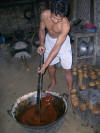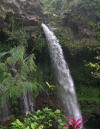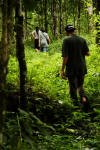mountslametecotour
Come experience the wilderness, nature beauty, and local custom in the mountainous surrounding of southern central java. Mount Slamet is the second highest mount in java island, and is home to pristine rainforest and beautiful wildlife. Your stay will be valuable time to learn the harmony local livelihood practiced by local community with sustainable agriculture and forest manangement. The mount is a huge water tower for the five densely populated urban areas.
Thursday, May 18, 2006
About Mount Slamet
Lies on western part of Central Java province, Mount Slamet (3428 meter a.s.l.) is the second highest on Java island and is therefore holds wide area spread over five regencies. The mount’s vast area serves important role as huge water catchments to many municipalities below. Eleven big rivers flow down from the mount and supplies water for eight dams used for both irrigation and power plant. In the coming years when water fulfillment is our next problem, Mt Slamet function as water tower will be more critical.
Mount Slamet is also important for the conservation of biodiversity since it holds approximately 10,000 hectares of recently-rare tropical Javan forest. The altitude range between 500 and 3000 meter makes possible for the forest to perform three vegetation patterns i.e; lower mountain forest, mountain forest, and alpine forest. Vegetation patterns and local climate also differ among each side of the mount due to different position to sunrise, wind direction, and rainfall. In general, Fagaceae, Lauraceae, Theaceae, Magnoliaceae, Podocarpaceae, Junglandaceae, Ericaceae, and Balanophoraceae are the main families of plant composing Mt. Slamet forest.
The forest of Mt Slamet is home to many species of wildlife, some of them are endemic and threatened, e.g. the Javan Hawk Eagle (Spizaetus bartelsi) and the Javan Gibbon (Hylobates moloch). Primates are easily encountered by early and end of day swinging through the trees with attractive movement. Here, we can find four endemic primates, the Javan Gibbon, Javan Langur (Trachypithecus auratus) Rekrekan (Presbytis fredericae) and the shy-Javan Loris (Nycticebus coucang). Other wildlide like predators such as leopard and cats can be recognized by their footprints, wood-scratches, hairs, and feces.
The People. Most communities living in the foothill areas of Mt Slamet live by utilizing forest resources. Thus, forest sustainability is very important for the continuance of their life. Honey, herbal medicines, mushroom, and other food sources are the forest products that usually harvested by locals in order to sustain life in a manner that keeps the sustainability of forest function. Local rule on the utilization of forest product has been set by their ancestors hundreds years ago and is still obeyed until today. For example, they’re forbidden to sell timber, it’s allowed for building house only. The role of local communities in protecting the sustainability of the forest is therefore undisputed.
Agriculture. In some villages, farmers retain the use of traditional (non-conventional) agriculture systems to prevent the food and the environment from hazardous chemicals contamination. Indigenous knowledge has been combined with organic farming to support the resurgence of sustainable farming once demolished by green revolution.
Packages
During several days of living in the village and interacting with the people you’ll find that this package is more than just a tourism visit. Moreover you’ll learn how people manage local resources to sustain their life. You’ll be guided by local community to learn about sustainable agriculture practices, non-timber forest products harvesting, and herbal medicine processing. In the end, the whole time spent will be a joint-learning process about the natural resources utilization.
Sustainable Agriculture. During around thirty years practicing the ‘chemical agriculture’ of green revolution, the Indonesian farmers suffer great loss such as local crops variety decrease, soil damage, and high dependence on external components. Since 2001 most farmers in Kalipagu committed to return to traditional farming to save agriculture in order to save their agriculture production. The ‘black rice’ is one of local variety that is saved through this program. To support the application of sustainable farming, husbandry has been integrated into it. Livestock provide manure used as organic fertilizer for the crops. On the other way, parts of harvested crops are processed to become animal’s nutrition.
Agroforestry. The agroforestry is well-maintained in the steep terrain to prevent it from landslides. Agroforestry product consists of timber, bamboo, coconut, palm sugar, Gnetum, and fruits like durian, rambutan, jackfruit, avocado, etc. Moreover, the agroforestry system also provides energy source (firewood) and cattle nutrition.
Palm Sugar Processing. Along the villages trekking route you’ll find many coconut trees. Villagers process coconut water collected in a bamboo tube to become palm sugar. The product is classified into two shapes i.e; the bar sugar and powder sugar.
Herbal Medicine. One of non-timber forest products regularly utilized by local people is medicinal plants. You can learn traditional pharmacology that uses plants’ components such as root, leaves, and fruits as the raw materials.
Sustainable Energy.
Traditional Art. The people of
Trekking and River Crossing. When trekking across the trail at the forest edge, you’ll enjoy the beauty of nature landscapes such as hills, valleys, rice fields, rivers and waterfall. In the morning and late afternoon, the singing of birds and primates will give more excitement to your adventure experience. You’ll also feel the freshness of mountain spring when crossing the Logawa river and enjoy the beauty of Gomblang waterfall.
Routes to choose:
Kalipagu—Baturraden—Windusari (short route, excluding palm sugar making and Gomblang Waterfall)
Sunyalangu—Windusari—Kalipagu (long route, excluding Seven Spout and Sulphur Massage)
Food and Beverages
On the arrival, you’ll enjoy welcome drink consists of fresh coconut water and local foods (cassava, palm sugar, peanut, banana, corn served in various ways). Some menu are highly recommended to taste for their originality e.g. Javan salad called ‘pecel’ with soya sauce, grilled fish, and the special local menu the ‘Black Rice’ cone, usually made for ‘thanksgiving’ ceremony purpose.
Handicrafts. Banyumas, the closest city from Mt Slamet is known for its unique culture. There are traditional clothe painting (bathik) in Banyumas, ceramics outlet and workshop in Klampok district, Bamboo furniture, Sokaraja Painting, and
SPECIAL PACKAGES - WILDLIFE RESEARCH
If you are a researcher, adventurous, or fond of wildlife observation
In this special purpose trip we provide several packages as follow.
A. Tiger Tracing
A real challenging trip to seek for traces left by Javan Tiger (Panthera tigris sondaica) activities. Scientists believed that this top predator of rain forest has extinct, but local people still believing they remain survive based on some encounter recently. Together with NGO’s, local people have been collecting footprints, wood-scratch, and feces of carnivores considered typical to Javan Tiger. The latest hair analysis conducted by Javan Tiger Focus Group (JTFG) proves that this top-predator still exists.
B. Primates Identification and Census
Primates are the agent of forest regeneration. They feed on some fruits and spread the seeds to entire part of the forest. Many species of primates including monkeys and ape inhabit Mt Slamet forest.
The detection of primates can be done by sighting and their calling. The only ape species found in Java, the Javan Gibbon (Hylobates moloch), dwells in the natural forest and is easily recognized by its calling. Periodic census is conducted to help monitoring the status of their population.
C. Birdwatching
Of all the wildlife, birds are the easiest to find. There are many kinds of bird over like raptors, flycatchers, pigeon, woodpecker, etc. There are several interesting behaviors to observe like feeding, nursery, territory protection, and nest activities. Some birds are specific to certain habitats, so that their presence becomes indicator of change on local ecosystem. Observation of birds can be both identification and census.
D. Mammals Identification and Census
Mammals can be identified by their footprint, hair, and feces. The footprints of deer and pigs are the most commonly found among others. But sometimes, we’ll find a rare species like chevrot (Tragulus javanicus). Mammals are very adapted animal in the forest, as long as they can get their food for browsing or grazing, especially herbivore. But, in the mountain forest they cannot found easily. Become an unique experience can observe their behavior.
Special Site
There is special site to observe mammal, carnivore, primate, and birds that lies deep in the forest. This spot, namely Taman Wlingi, is a temporary swampy valley surrounded by hills at elevation 2100 meter a.s.l.
E. Butterfly Identification
To observe butterflies, one can only take a walk at forest edge so that this can be considered as the easiest trip in biodiversity observation. They can be found at the edge of forest, riverside, and under-storey vegetation. 24 butterfly species have been reported exist in
F. Orchid inventory
This journey will challenge your team to visit the dark, cloudy at the outlying part of the forest. At very humid forest part, with small portion of sunlight, the most beautiful orchids of Java will be found, including terrestrial and epiphyte.
Equipment
All visitors wishing to observe the wildlife suggested carrying the following equipments:
Binocular
Camera
Raincoat
Handbooks about Java wildlife identification
Personal medication
Trekking shoes
Backpack
Philosophy
our planet is more than enough to live in, but it never be enough for our greediness
What we offer
To bring the spirit of living harmoniously with the nature, we take tourists and travelers on a visit to places where beautiful nature sightings and cultural richness occur. At the mountain region, travelers will learn and experience the way that host community utilize natural resources wisely.
Saving the earth through sustainable use of natural resources. We promote responsible tourism at places where anyone can taste the experience of living harmoniously with the nature and bring home the spirit into their daily life.
ABOUT US
We’re a group of persons whose experience in traveling and environmental campaign since 1995. After graduating from university we began to promote the ecotourism program combining both traveling activity and campaign/education on sustainable natural resources management.
History
Since year 2000, together with Caring Community of Mt. Slamet (KOMPLEET) we organized local people to develop their capacity in managing the forest and other local resources with indigenous knowledge. Still Collaborating with KOMPLEET, this community based eco-tourism project is designed to improve their management skill and income beside other activities, like farming and forestry. Someday, we hope they can run this project by themselves with own management.
Management team :
1. Coordinator : Fitri
2. Research and Development Manager : Adi
3. Financial Manager : Heni
4. Community Empowerment Manager : Jalu
Comment from our previous customers
Jan Glisenaar (wederzijds@hetnet.nl) : We’d like to visit here again, at least another group of wederzijds (2004).
Wim de Bock (teacher) ; Good to see all the things done to solve the problems in this village. The project is pleasant, good mix, free, study and fun (2005)
Joke Koehler (Book Editor, woman activist) : Very good hosts and guide in the forest, who were very helpful. I appreciate the discussion with the women! (2005)
Ferdinand Brul (handicraft volunteer) : Impressive, Educated, lovely people (2005)
Willem Groenewegen (Documenter film maker; dh.debock@tiscali.nl) : The days were good and I learned a lot about the people here and their possibilities and impossibilities with the nature. Goes on in this way (2005).
How to get there
From
From
Travel services are also available both from






